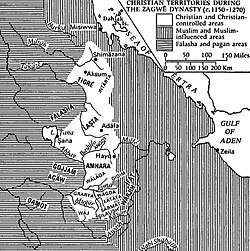
Back Zagwe-dinastie Afrikaans سلالة زاغو Arabic Dinastia Zagüe Catalan Zagwe-dynastiet Danish Zagwe-Dynastie German Zagŭea dinastio Esperanto Dinastía Zagüe Spanish Zagwe dinastia Basque Zagwés French שושלת זאגווה HE
Zagwe dynasty ዛጔ መንግሥት (Amharic) | |||||||||
|---|---|---|---|---|---|---|---|---|---|
| 1137–1270 | |||||||||
 Christian territories during the Zagwe Dynasty circa 1200 AD | |||||||||
| Capital | Adefa[1] | ||||||||
| Common languages | |||||||||
| Religion | Ethiopian Orthodox Tewahedo (official)[5] | ||||||||
| Government | Absolute monarchy | ||||||||
| Negus (King) | |||||||||
• early 12th century | Mara Takla Haymanot | ||||||||
• 13th century | Yetbarak | ||||||||
| History | |||||||||
• Established | 1137 | ||||||||
• Other theories for the start | c. 930 | ||||||||
| 1270 | |||||||||
| |||||||||
| History of Ethiopia |
|---|
 |
The Zagwe dynasty (Amharic: ዛጔ መንግሥት) was a medieval Agaw monarchy that ruled the northern parts of Ethiopia and Eritrea. The Agaw are a Cushitic ethnic group native to the northern highlands of Ethiopia and neighboring Eritrea.[6] It ruled large parts of the territory from approximately 1137 to 1270 AD, when the last Zagwe King Za-Ilmaknun was killed in battle by the forces of the Amhara King Yekuno Amlak. The Zagwe are most famous for their king Gebre Meskel Lalibela, who is credited with having ordered the construction of the rock-hewn monolithic churches of Lalibela.
The name "Zagwe" is thought to derive from the ancient Ge'ez phrase Ze-Agaw, meaning "of the Agaw", in reference to the Mara Tekle Haymanot, the founder of the dynasty.[7] This term does not appear in contemporary sources, neither in indigenous documents nor in accounts of foreign observers.[8]
David Buxton has stated that the areas under the direct rule of the Zagwe kings apart from the centre of power in Lasta "probably embraced the highlands of modern Eritrea, Tigray, Wag and Bete Amhara and thence westwards towards Lake Tana (Begemder)."[9] Unlike the practice of later rulers of Ethiopia, Taddesse Tamrat argues that under the Zagwe dynasty the order of succession was that of brother succeeding brother as king, based on the Agaw laws of inheritance.
- ^ Taddesse, Tamrat (1977). "Ethiopia, the Red Sea and the Horn". The Cambridge History of Africa: Volume 3 (PDF). pp. 98–182. doi:10.1017/CHOL9780521209816.004. ISBN 978-1-139-05457-7.
- ^ Mohammad Hassan, The Oromo of Ethiopia, p. 3
- ^ Demeke, Girma A. (2014). The Origin of Amharic. The Red Sea Press. p. 53. ISBN 978-1-56902-379-2. OCLC 824502290.
- ^ Edward Ullendorff, The Ethiopians, Oxford University Press, 1960
- ^ Falola, Toyin (2002). Key Events in African History: A Reference Guide. Greenwood Publishing Group. p. xv. ISBN 978-0313313233.
- ^ Concise Encyclopedia of Languages of the World. Elsevier. 2010-04-06. ISBN 9780080877754. Retrieved 2023-10-25.
- ^ Oliver, Roland (1982). The Cambridge history of Africa: From c. 1600 to c. 1790. Vol. 1. Cambridge University Press. p. 112.
- ^ Marie Laure Derat (2020): "Before the Solomonids: Crisis, Renaissance and the Emergence of the Zagwe Dynasty (Seventh–Thirteenth Centuries)" in A Companion to Medieval Ethiopia and Eritrea. Brill. p. 47
- ^ Buxton, David (1970). The Abyssinians. New York: Praeger. p. 44. ISBN 0-500-02070-1.